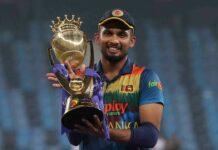An analytical chemist who specialised in quality assurance, Ajith CS Perera loved cricket dearly. He was especially interested in the laws of the game and decided to pursue umpiring. But sometimes, expectations don’t align with reality.
Expectations: Perera fulfills his dreams of becoming a Test umpire and goes on to officiate 60-odd Tests and nearly triple that figure in ODIs.
Reality: 17 days shy of officiating in his first Test match, Perera is travelling in his car during a rainy day in Colombo to convey the happy news to his parents. A tree falls on his car, kills his driver and leaves him a paraplegic for life.
Perera was left with two choices: he could either resign himself to a less-than-pleasant reality, or try to change his destiny. Made of sterner stuff, Perera chose the latter.
Perera had played Division I cricket during his University days, but he always found himself intrigued by the rules and regulations of the game. He decided to attend a training programme conducted by the Sri Lanka Cricket Umpire Association. There were 60 people gathered, a number made all the more intimidating by the fact that there were former Sri Lanka cricketers in the mix. Perera was one of the five that had passed the test and later qualified as an umpire in 1975 while he was still an undergraduate.
After attaining his Master’s degree and working as a University lecturer for a brief period, Perera became a senior manager in the pharmaceutical industry. But he soon grew tired of the hectic 8-to-5 lifestyle. His only recreational activity was umpiring on the weekends. And so, he decided to forge a second career in cricket.
Sri Lanka, by then, had gained Test status, in 1982, but many teams were reluctant to tour the country. Perera realised he would have to travel abroad for practical experience. He went to England and, after getting 97.5 marks in an oral and written exam conducted by Cricket Umpire Association of England, became a qualified umpire in 1985. He also became a qualified scorer in 1987, passing the exam with 99.5 marks.
His dedication to his craft impressed Lancashire County Cricket Club and they requested that he come to England for five months and officiate in four-day county Second XI matches and leagues in the area. He soon found himself in elite company, umpiring matches with Don Oslear, the former Test umpire. Perera and Oslear even became the first umpires to officiate a match using a stump camera during the four-day county Second XI championship match between Lancashire and Somerset in 1990.
Perera, however, had to wait until November 10, 1992 to be selected by the Sri Lankan Cricket Board to join the six-member panel of Test match umpires for the series against New Zealand. It was decided that he would officiate in the first Test alongside KT Francis, the Sri Lankan Test umpire. Unfortunately for Perera, that never materialised.
“I didn’t understand the gravity of the situation, so I thought I’d be okay by March 1993, when England would be touring Sri Lanka. I never realised I would never stand up again,” explained Perera to Wisden India.
There were no MRI facilities in Sri Lanka at the time nor were there doctors that specialised in spinal cord injury, and Perera was left battling for his life in Colombo National Hospital. It wasn’t until ten months later that the Royal Society of Chemistry in London heard of his plight and immediately flew him to England for treatment.
“There, I learnt to resurrect my life,” said Perera. “I saw how people worse off than me had improved their quality of life. I saw people in wheelchairs go to football grounds and cricket grounds and enjoy the game. I realised I would need to create awareness in Sri Lanka.”
After Sri Lanka won the 1996 World Cup, Perera, who had watched all the matches and diligently kept score, decided to write a book, The Golden Era of Sri Lankan Cricket, detailing the side’s progress in the one-day arena. In 2001, he wrote a second book, Thinking Cricket, a training guide for players and coaches alike. In the process, he also shattered the notion that a person confined to a wheelchair couldn’t achieve much. Christopher Martin-Jenkins, a BBC commentator and close friend of Perera, even declared him a “Sri Lankan Don Bradman” for his contribution to cricket.
Perera also founded a voluntary organisation called Idiriya (‘moving forward’ in Singhalese) and battled to make environments user-friendly for elderly people as well as the disabled. “There are so many disabled people who want to watch cricket,” said Perera. “But the stadiums are only accessible in bits and pieces … making steps accessible doesn’t help if the bathrooms are not accessible. Elderly people have the time and money to watch cricket, but they are often excluded.”
Society tends to have a myopic view when it comes to the disabled: people, by and large, sympathise when they ought to empathise. Perera, despite his years of experience, can’t even become a third umpire because stadiums in Sri Lanka are not fully wheelchair-accessible. His expectations might not have aligned with reality, but by not affording Perera and countless others an equal opportunity, it is cricket that stands to lose the most.
























